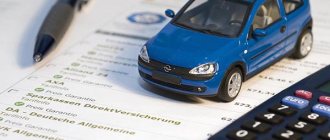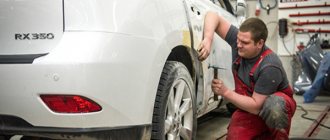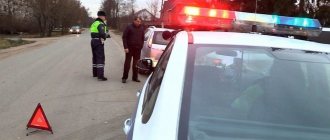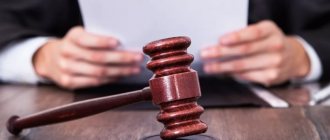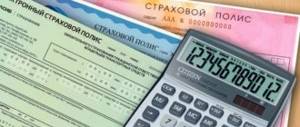One of the types of accidents on the highway is a non-contact accident. It involves creating an obstacle for another motorist, who, in turn, harms third parties, but there is no collision with the culprit. This often happens at intersections where people don’t want to give way, turn around in prohibited places, or try to quickly run through a red light. In such a situation, there is no accident without damage, since the car or road objects are damaged. The difficulty of obtaining compensation lies in the fact that there is no direct confrontation with the culprit. But if you prove his involvement, then there will be no problems with payment.
What is a non-contact accident?
A non-contact accident is a situation on the road when one participant creates an obstacle for another. As a result of such interference, a third party suffers harm: it can be moral, physical or material. In this case, there is no direct contact with the culprit. For example, a driver makes a U-turn in a prohibited place, and an oncoming car moves to the right to avoid a collision and crashes into a tree. The complexity of this type of accident is as follows:
- The culprit escapes from the scene with impunity, and it is not possible to find him.
- Incorrect interpretation of what happened, for which the injured party bears responsibility.
- Difficulty in holding accountable a person who was not injured in an accident.
Attention! If no people were injured and the vehicles are completely intact, then it is not classified as an accident. It will not be possible to obtain moral damages from the culprit. There must be damage, at least minimal. All drivers need to know what a non-contact accident is in order to understand in what situations and how the person at fault should be held accountable.
Determination of the culprit
Determining who is at fault for the accident is within the powers of the state traffic inspectorate or the court.
When a violator is identified, traffic police officers draw up a resolution and issue documents to all participants in the incident. They record the violator of traffic rules, and not the person responsible for the non-contact accident. With sufficient evidence, the violator will be able to recover damages from the culprit.
Dear reader! Didn't receive an answer to your question? Our expert lawyers work for you. It's absolutely free!
- Moscow ext 152
- St. Petersburg ext 152
- All regions ext 132 (Toll free)
Nuances of an accident without contact
A characteristic feature of a non-contact road accident is the absence of damage to the person responsible for the accident, since he only provokes it, but does not participate in it himself. In this case, lawyers help the driver achieve justice. Recordings from a DVR will be a big advantage. In addition, it is important to ensure that the protocol does not indicate that the driver decided to perform a maneuver instead of braking. In this situation, there will be no recovery from the culprit or compensation from the insurance company. Why does a non-contact accident happen:
- Aggressive driving style. There are a number of drivers who move along the road, paying little attention to other road users, which leads to accidents.
- Incorrect distance selected. When the distance to the nearest car is too short, it is difficult to take measures to prevent a collision.
- Speed limit violation. Driving too fast, overtaking on narrow roads, all this leads to the fact that other motorists are forced to avoid collisions in dangerous ways.
- Failure to comply with traffic rules. The most common reason. Most often this is driving through a red light, overtaking on a closed turn, and more.
Non-contact accidents are regulated by the same provisions as other types of accidents on highways. Therefore, the design rules must also be followed. If damage is received in the form of damage to the car, and the second participant agrees that he is at fault, it is not necessary to call traffic police inspectors. If there is a mutual decision, a European protocol is drawn up. According to it, you can receive compensation of no more than 100 thousand rubles.
Payments under compulsory motor liability insurance in case of a non-contact accident
When purchasing a compulsory insurance policy, motorists cannot change the list of insured events. Thus, when recording an incident in a non-contact accident, it is necessary to pay attention to the following features:
- The guilt must be established (one driver or several);
- The identity of the guilty participant must be known (the search for the escaped participant is entrusted to employees of the Ministry of Internal Affairs, but the victim can provide any evidence or information);
- A cause-and-effect relationship has been established between the actions of the guilty party and the consequences that have occurred.
All evidence and evidence of guilt must be collected immediately after the accident. Obtaining insurance under the MTPL policy will take place in accordance with the general rules.
The victim can go to court if representatives of the insurance company unlawfully refuse to pay. Also, the judicial practice of the last two years has proven that if compensation is incomplete from the insurance company, the remaining funds can be demanded from the culprit.
Design rules
An accident without direct contact is registered in accordance with the general procedure. After the incident, the parties must stop the vehicles, get out of the cars, and assess the approximate amount of damage received. According to the provisions of the traffic rules, an emergency sign is posted at a distance of 15 m in the city, and 30 m outside the populated area. If there are victims, you must call an ambulance and notify the traffic police about the incident.
Advice! Before the inspectors arrive, it is necessary to take photographs or start video recording, interview witnesses, and provide first aid to the victims. All testimony will be entered into the protocol later. It is strictly forbidden to leave the scene of the accident, try to catch up with the culprit, or resolve everything peacefully when there are people with injuries.
How is the culprit determined?
Since there is no physical contact between the vehicles, it is most difficult to determine who was at fault in the accident. The most reliable evidence is video recording on the recorder, but if there are no license plates, then bringing the driver who fled the scene of the incident to justice will be quite problematic. Law enforcement agencies are involved in this. What is the difficulty:
- The culprit created an obstacle and fled the scene of the accident.
- The victim was held accountable due to an incorrect interpretation of clause 10.1 of the traffic rules.
- The obstacle was caused by a pedestrian crossing the road in an inappropriate place.
- A wild animal provoked an emergency situation.
It is important to know! If the owner of the vehicle is a legal entity, then the victim recovers the payment from him. An auto technical examination can prove the guilt of a particular driver.
Registration procedure
The procedure for filing a no-touch accident is the same as for a regular accident:
- Do not leave the scene of the incident.
- Call the traffic police.
- Collect contact information from citizens who witnessed the accident.
- The report describes in detail what happened.
- Make sure that the traffic police officer records the testimony of all witnesses present.
- If the accident did not happen without damage, describe in detail the severity and number of consequences in the report
- Be sure to indicate in the protocol if you do not agree with some points and wording.
If the culprit fled the scene of the accident, try to remember the make and number of his vehicle. We also recommend asking other road users whether they have any DVR recordings of the incident. In the future, this will help prove the guilt of the one who provoked the non-contact accident.
How to identify the culprit
The traffic participant who performed the maneuver that led to the collision of vehicles is guilty of causing an accident. The difficulty lies in the fact that it is quite difficult to identify the provocateur. In such a situation, there may be several people responsible for the incident: the driver who provoked the accident, and the motorist who was forced to make an uncharacteristic maneuver, which led to the collision.
In addition, traffic police officers often assign responsibility for the incident to the victim who took actions to get away from an unexpected obstacle. The thing is that, in accordance with paragraph 10.1 of the traffic rules, if a danger arises on the road, the driver must reduce the speed or stop. In this case, it will be necessary to prove that sudden braking could lead to serious consequences, for example, the death of road users.
Responsibility for leaving the scene of an accident
Leaving the scene of an accident by the perpetrator of a non-contact accident is a fairly common situation. In this way, many try to avoid responsibility. But this action entails unpleasant consequences, which are expressed in the following punishment:
- Deprivation of a driver's license for up to 1.5 years.
- Administrative arrest for 15 days.
- A fine in the amount of six months' income.
Therefore, it is strictly forbidden to leave the scene of an accident if an incorrect maneuver causes a collision between another traffic participant and a pole or second car. Then the consequences will be more serious than the punishment determined for a non-contact accident.
Will there be compensation from the insurance company?
Many drivers are interested in the question of whether a non-contact accident is subject to compulsory motor liability insurance in order to receive payments. There is no definite answer here, since everything directly depends on the correctness of the documents, as well as bringing the culprit to justice. In many cases, the insurance company refuses because the driver hits a pole and there is no clear evidence that a third party was involved.
Due to an incorrect maneuver by another driver, motorists often crash into poles or fences. Then you should not count on payments, since the actions are considered illegal. It will be possible to achieve compensation only in a situation where the examination issues a conclusion that reflects that it was technically impossible to avoid such a collision. That is, the cause-and-effect relationship with the actions of the culprit and the result obtained must be documented.
It is important to know! It is also important what is written in the traffic police report. If it indicates the culprit and the victim, then payment for a non-contact accident is received within the framework of compulsory motor liability insurance. The issue of compensation can be resolved immediately if the other party did not flee the scene of the incident. But this happens extremely rarely.
About the features
What are the features of a non-contact emergency:
- There is a party that provoked the occurrence of an emergency, but did not itself take a direct part.
- Often, a car enthusiast who creates an emergency situation disappears from the scene, but his actions are incorrect, since all events are recorded on the recorders. You can easily prove what happened in court.
- The protocol indicates that the driver made a maneuver to avoid a collision with another vehicle. The injured driver is found guilty.
- The regulation of litigation is interpreted on the basis of legislation.
- Such cases are classified as insurance cases and compensation for the damage caused is due.
- Compensation for damages does not apply here, so the regulations do not apply here.
- The injured citizen must apply for insurance payment to the company where the culprit of the accident is registered.
Payments of compensation are difficult to obtain; quite often you have to go to court. If there is no direct evidence of guilt, then spending money will be pointless.
Going to court
You can defend your rights and demand compensation for damage received in a non-contact accident in other ways.
Where to go if the insurance company refuses: to the court, presenting all the evidence that you have on hand. Practice shows that in this case there are more chances to achieve a positive decision. When writing a statement of claim, it is necessary to focus on the existing evidence that you are right. This is a protocol issued by the traffic police, video recorder recordings, and written evidence from the parties. The court considers all the circumstances of the case and makes a decision based on the existence of violations of rights. A non-contact accident is a complex situation on the road that arose due to an unsuccessful maneuver. Even the Supreme Court interprets the definition in its decisions. The culprit is not directly involved in the collision, but only provokes it. The complexity of such a case lies in the fact that it is extremely difficult to hold the other party accountable, as well as to obtain compensation. But if you know the basic rules for determining the culprit, then you will have a greater chance of effectively protecting your rights.
Appeal under OSAGO
Let's move on to the chronology of events.
Regardless of who received the decision, when you contact the insurance company for payment, you may be denied simply on the grounds that the accident was non-contact. That is, the insurer may doubt the existence of the insured event itself - that the accident occurred due to the fault of the driver with whom you had no contact.
In this case, the procedure is more complicated:
- first you need to carry out an independent examination of the damage in order to find out how much to apply for,
- Next, you need to submit a pre-trial claim to the insurer demanding compensation for damage - in it, state the essence of the non-contact accident, what you are demanding and on what basis,
- If the pre-trial claim is refused, all that remains is to file a lawsuit.
Which insurance company should I contact?
There are 2 important conditions (clause 1 of Article 14.1 of the Federal Law-40) in order to make it possible to contact your insurance company:
- There are no casualties in a non-contact accident,
- 2 or more cars collided in an accident.
And, if everything is clear with the first point, then misunderstandings may arise with the second. The law implies a collision - that is, the contact of both cars. If there are only two participants, but only one car was damaged (for example, it flew into a ditch when the first one did not give way or cut off), then you do not fall under this condition.
But the paradox is that if, similarly, they did not give way to you, and as a result you drove into a third car, then there are three participants, but two collided, and you qualify for direct compensation for losses, so you only need to contact your insurance company.
Here is an example of judicial practice where the plaintiff was denied compensation by the court because he contacted his insurance company.
Also note that contacting your insurance is an obligation, not an option. If the 2 conditions above are met, you cannot contact your company, but are obliged only to contact it. Otherwise, only contact the culprit’s insurer.
Is it possible to issue a European protocol?
No. An important condition for issuing a European protocol notification is a collision of 2 vehicles, and in a non-contact accident, either there are more participants, or only one of the participants is touched and damaged.

